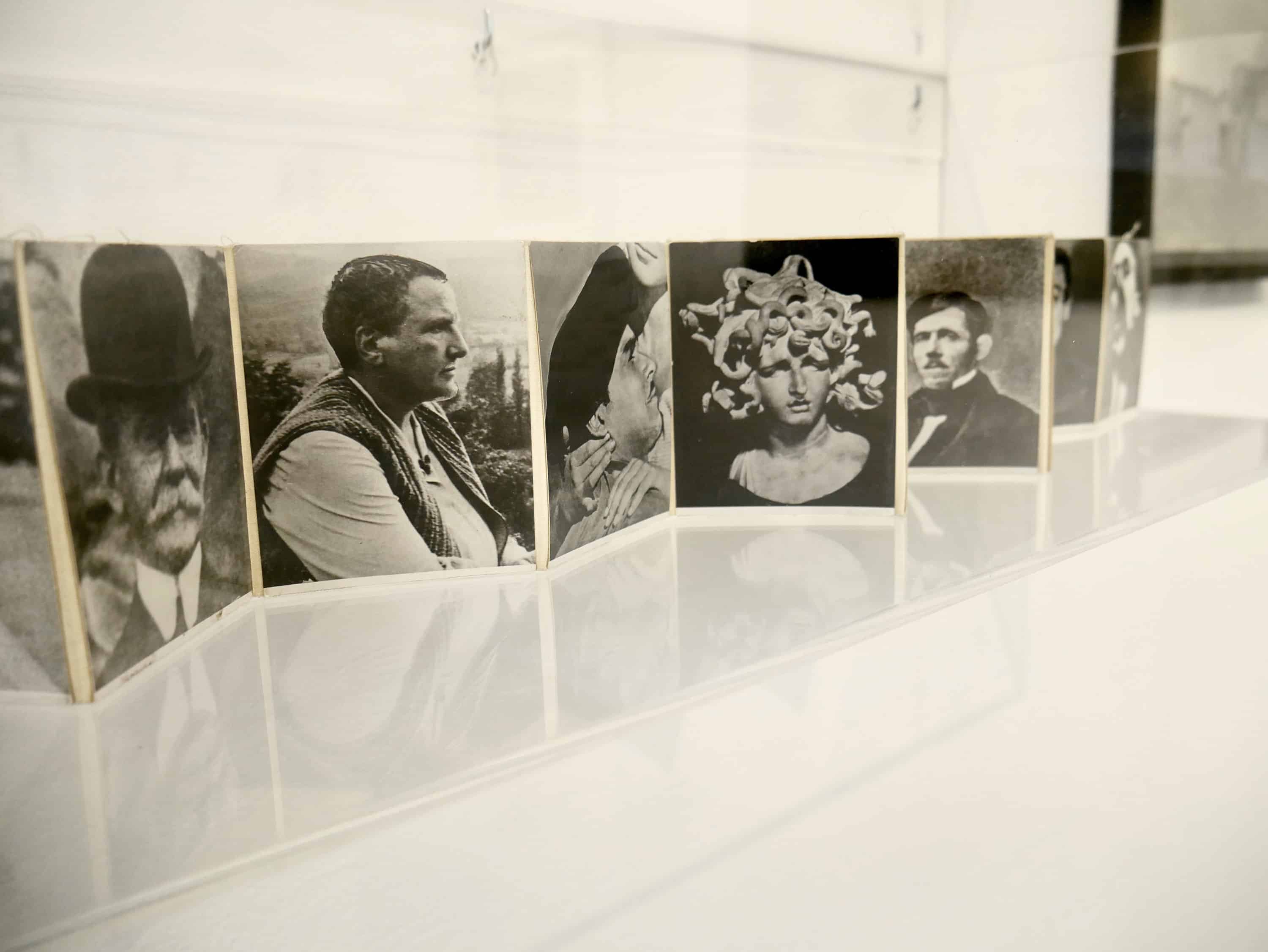A high-angle photograph, perhaps taken from a balcony overlooking a backyard, captures a group of men or, to be more precise, the tops of their heads looking down. The photograph titled „Gorgona is looking at the ground” was taken in 1961. An identical frame of the adjacent photograph portrays the same group of men, this time looking up, straight into the camera lens. One could easily discern their facial features and expressions, their distinct personality traits albeit similar, stylish suits. This photograph is entitled “Gorgona is looking at the sky.” Nearby, there are a couple of photographs documenting these same men playing football in a rural setting. This ephemeral action is called “Recreation Hour.” The picture showing the already familiar gang saluting the audience is displayed further inside and is titled “Gorgona Salutes the Arrival of the New Tendencies.” Who are these young gentlemen that slightly resemble jazz musicians? They are the members of the legendary neo avant-garde group from Yugoslavia whose work is featured at the exhibition held at the Profile Foundation in Warsaw from December 2019 until late January 2020.

Josip Vaništa, “Collective ID Card”, 1961, photo on canvas.
The name of the group, comprising Julije Knifer, Josip Vaništa, Đuro Seder, Marijan Jevšovar, Ivan Kožarić and Miljenko Horvat, originates from the three mythical creatures striking fear into the hearts of ancient Greeks. One of the Gorgon sisters had a face constantly changing its appearance, the other, named Medusa had snakes for her hair, while the third sister could petrify and kill people with her gaze. Numerous meanings have been attributed to these highly symbolic creatures. Having a shared origin, they resided together in Hades, the land of the dead. And one more thing – the Gorgons enjoyed playing with human life.
In an interview presented as part of the exhibition, Josip Vaništa – one of the Gorgona Group members – describes the socio-political context of the group’s activity in the following words: “Fifteen years of poverty. Half of Europe was under the Soviet rule. The landscape was ruined. The darkest years of the 20th century was the late period of Stalinism.” Yugoslavia bore a striking resemblance to Hades in the years 1959-1966, the time when the collective operated in Zagreb. The context of the soviet reality is of great importance to the foundation of the group. The members’ kinship and collective actions were a form of escape from the grey world and lack of perspectives in the Eastern Block. First and foremost, they forged male friendships by spending time together. In lieu of the ideological, political or social art practices, their art involved engaging in ephemeral activities and creating a cheery atmosphere of endless frolicking. The Gorgons and artists alike enjoyed playing with life.
GORGONA. Works from the Marinko Sudac Collection, exhibition, 2019, Profile Foundation
GORGONA. Works from the Marinko Sudac Collection, exhibition, 2019, Profile Foundation
The iconic black and white artwork “Meander” by Julije Knifer isn’t part of the show at the Profile Foundation. However, a reproduction of the piece is featured in the exhibited issues of the Gorgona anti-magazine – its limited number of copies was published and distributed around the artistic milieu in the 1960s. The large-scale meander was meant to signify “the escalation of uniformity and monotony,” the minimalistic repetitive form devoid of the unique qualities of gesture, real-life connection, symbolism and mimesis. Marijan Jevšovar enacted a similar gesture on canvas exhibited at the Profile Foundation, paintings that represent the radical art informel movement. These are painted in monochrome paint which builds structure, they often incorporate an element of geometry, as well as depart from the traditionally rectangular shape of their surface.
A correspondence written in Croatian is placed in glass cabinets. The letters, which the artists and critics wrote to each other, were filled with jokes and humor, often backdated or penned in office jargon. Similarly to mail-art, it was recognized as an art form. Additionally, the exhibition includes several photographs documenting the art shows at Studio G, an independent space where both the group’s members as well as selected artists from abroad would present their work. Clearly, the artistic approach of the Gorgona Group could be juxtaposed to the parallel pre-conceptual art practices dominant in Western Europe embodied by the likes of Yves Klein, Piero Manzoni and the Zero Group.

GORGONA. Works from the Marinko Sudac Collection, exhibition, 2019, Profile Foundation
The works exhibited at the Profile Foundation derive from Marinko Sudac’s private collection that consists of artworks from Central and Eastern Europe, spanning from the Baltic region to the area by the Black Sea. For the last twenty-five years, the collector has worked with some of the most renown museums in the world to present his art collection to international audiences, thus propelling the integration of art produced behind the Iron Curtain into the contemporary art canon. Inspired by the unique energy emanating from the art of the Eastern Bloc, singular radicalism and blatant opposition to the pre-established social order, Sudac has amassed the art collection dedicated to the rebels, artists alienated from the mainstream system who formed small friend groups, such as the Gorgona.
The Gorgona Group’s exhibition at the Profile Foundation constitutes another installment in the series of Warsaw based shows focusing on the neo avant-garde practices in Central and Eastern Europe. The projects implemented by the gallery thus far testify to the fact that these artists transcended the geographic and political borders by creating their independent network of associations, meetings and festivals. In recent years, the foundation’s activity resulted in its vastly expanded pool of collaborators including experts and institutions from the region. These initiatives culminate insignificant events such as the Recordings Festival which presents documentation of artistic activities performed in the late 20th century.
Written by Michalina Sablik
Translated by Karolina Jasińska
Edited by Maria Sołyga
GORGONA. Works from the Marinko Sudac Collection, exhibition, 2019, Profile Foundation
GORGONA. Works from the Marinko Sudac Collection, exhibition, 2019, Profile Foundation














